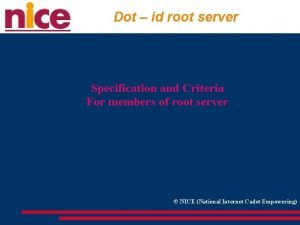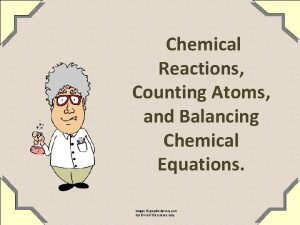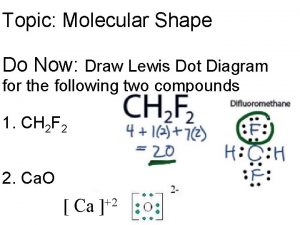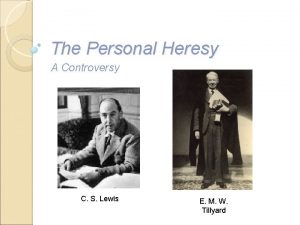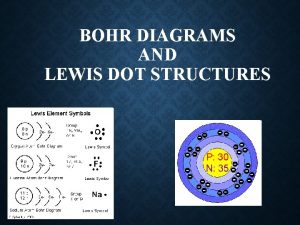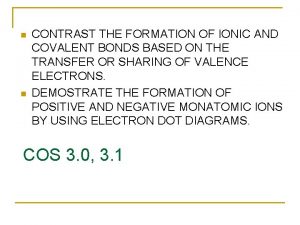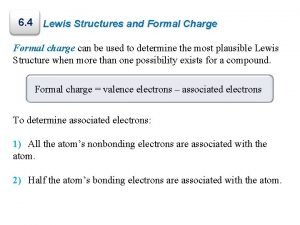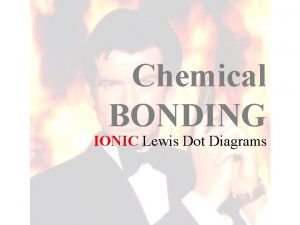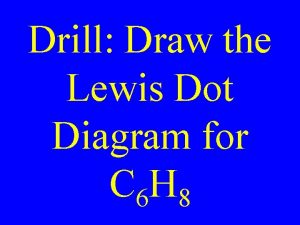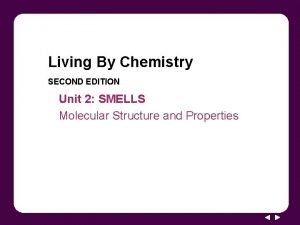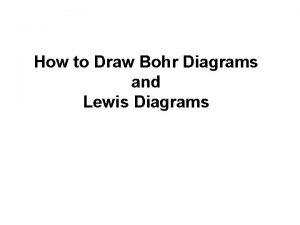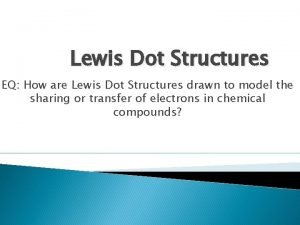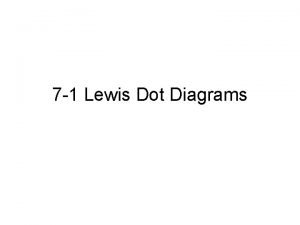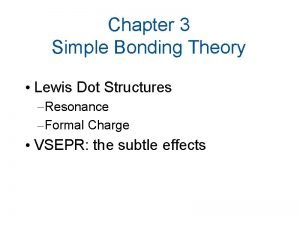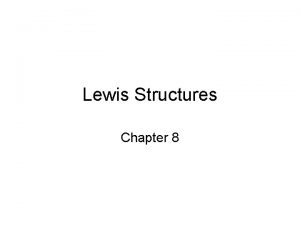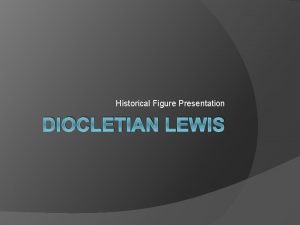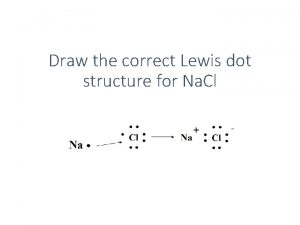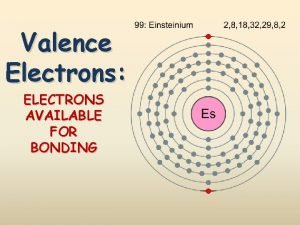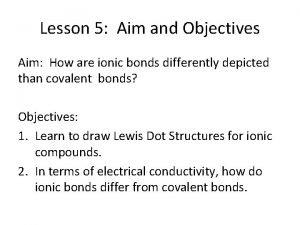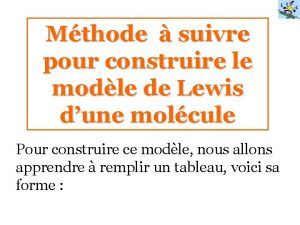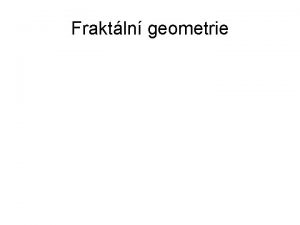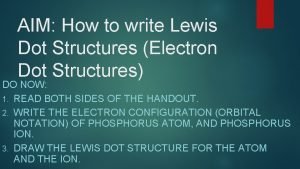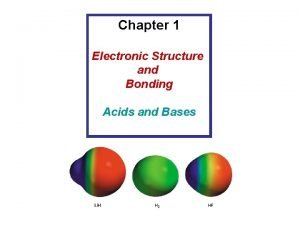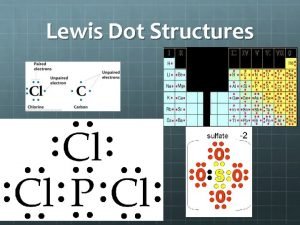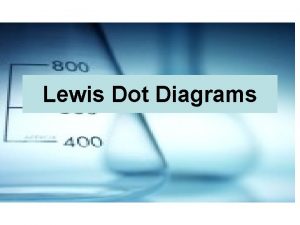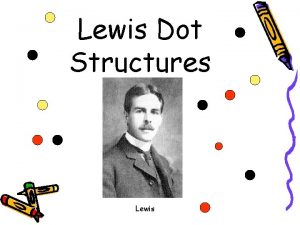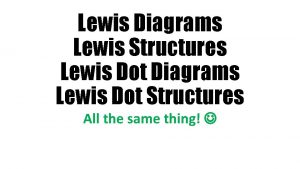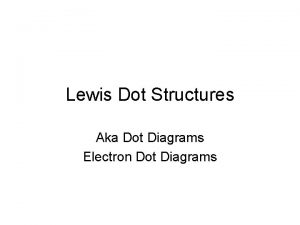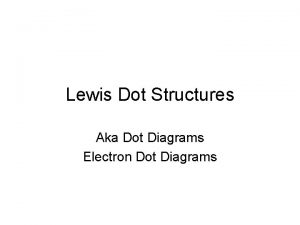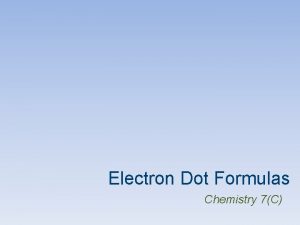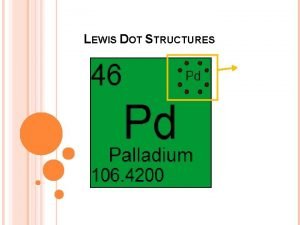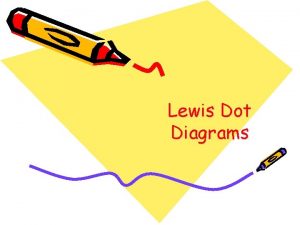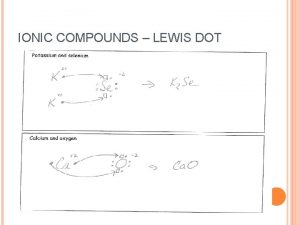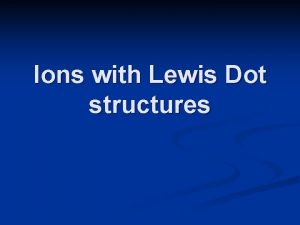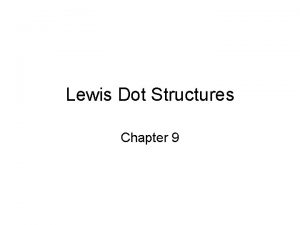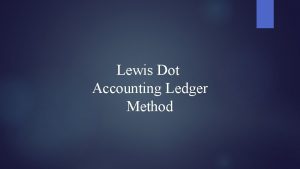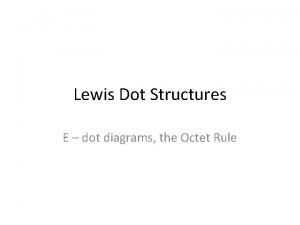Lewis Dot Formulas of Atoms Lewis dot formulas































- Slides: 31

Lewis Dot Formulas of Atoms Lewis dot formulas or Lewis dot representations are a convenient bookkeeping method for tracking valence electrons. l • Valence electrons are those electrons that are transferred or involved in chemical bonding. 1

Formation of Covalent Bonds We can use Lewis dot formulas to show covalent bond formation. 1. H 2 molecule l 2. HCl molecule 2

Lewis Dot Formulas of Atoms 3

l Elements in the same periodic group have the same Lewis dot structures. 4

Lewis Formulas for Molecules l First, we explore Lewis dot formulas of homonuclear diatomic molecules. 1. Hydrogen molecule, H 2 2. Fluorine, F 2 3. Nitrogen, N 2 5

Lewis Formulas for Molecules Hydrogen chloride, HCl 6

Lewis Formulas for Molecules Water, H 2 O 7

Lewis Formulas for Molecules l Ammonia molecule, NH 3 l Ammonium ion, NH 4+ 8

Writing Lewis Formulas: The Octet Rule l l l The octet rule states that representative elements usually attain stable noble gas electron configurations in most of their compounds. Lewis dot formulas are based on the octet rule. We need to distinguish between bonding (or shared) electrons and nonbonding (or unshared or lone pairs) of electrons. 9

Writing Lewis Formulas: The Octet Rule l l N - A = S rule N = number of electrons needed to achieve a noble gas configuration. • • l A = number of electrons available in valence shells of the atoms. • • l l N usually has a value of 8 for representative elements. N has a value of 2 for H atoms. A is equal to the periodic group number for each element. A is equal to 8 for the noble gases. S = number of electrons shared in bonds. A-S = number of electrons in unshared, lone pairs. 10

Writing Lewis Formulas: The Octet Rule l For ions we must adjust the number of electrons available, A. • • l Add one e- to A for each negative charge. Subtract one e- from A for each positive charge. The central atom in a molecule or polyatomic ion is determined by: • • The atom that requires the largest number of electrons to complete its octet goes in the center. For two atoms in the same periodic group, the less electronegative element goes in the center. 11

Writing Lewis Formulas: The Octet Rule l l l Write Lewis dot and dash formulas for hydrogen cyanide, HCN. N = 2 (H) + 8 (C) + 8 (N) = 18 (needed) A = 1 (H) + 4 (C) + 5 (N) = 10 (available) S= 8 (shared) A-S = 2 This molecule has 8 electrons in shared pairs and 2 electrons in lone pairs. 12

Writing Lewis Formulas: The Octet Rule Write Lewis dot and dash formulas for the sulfite ion, SO 32 -. N = 8 (S) + 3 x 8 (O) = 32 (needed) A = 6 (S) + 3 x 6 (O) + 2 (- charge) = 26 (available) S = 6 (shared) A-S = 20 l Thus this polyatomic ion has 6 electrons in shared pairs and 20 electrons in lone pairs. l Which atom is the central atom in this ion? l 13

14

Writing Lewis Formulas: The Octet Rule l What kind of covalent bonds, single, double, or triple, must this ion have so that the six shared electrons are used to attach the three O atoms to the S atom? 15

Resonance Write Lewis dot and dash formulas for sulfur trioxide, SO 3. N = 8 (S) + 3 x 8 (O) = 32 (needed) A = 6 (S) + 3 x 6 (O) = 24 (available) S = 8 (shared) A-S = 16 l 16

Resonance l There are three possible structures for SO 3. • The double bond can be placed in one of three places. Double-headed arrows are used to indicate resonance formulas. 17

Resonance l Resonance is a flawed method of representing molecules. 18

Writing Lewis Formulas: Limitations of the Octet Rule 1. The covalent compounds of Be. 2. The covalent compounds of the IIIA Group. 3. Species which contain an odd number of electrons. 4. Species in which the central element must have a share of more than 8 valence electrons to accommodate all of the substituents. 5. Compounds of the d- and f-transition metals. 19

Writing Lewis Formulas: Limitations of the Octet Rule l Write dot and dash formulas for BBr 3. • This is an example of exception #2. 20

Writing Lewis Formulas: Limitations of the Octet Rule l Write dot and dash formulas for As. F 5 and PF 5. 21

Polar and Nonpolar Covalent Bonds l l l Covalent bonds in which the electrons are not shared equally are designated as polar covalent bonds. Covalent bonds in which the electrons are shared equally are designated as nonpolar covalent bonds. To be a polar covalent bond the two atoms involved in the bond must have different electronegativities. 22

Polar and Nonpolar Covalent Bonds l l Some examples of polar covalent bonds. HF 23

Polar and Nonpolar Covalent Bonds 24

Polar and Nonpolar Covalent Bonds l Compare HF to HI. 25

Polar and Nonpolar Covalent Bonds l Polar molecules can be attracted by magnetic and electric fields. 26

Dipole Moments l Molecules whose centers of positive and negative charge do not coincide, have an asymmetric charge distribution, and are polar. • These molecules have a dipole moment. l l The dipole moment has the symbol . is the product of the distance, d, separating charges of equal magnitude and opposite sign, and the magnitude of the charge, q. 27

Dipole Moments l l l Molecules that have a small separation of charge have a small . Molecules that have a large separation of charge have a large . For example, HF and HI: 28

29

The Continuous Range of Bonding Types l l Covalent and ionic bonding represent two extremes. Most compounds fall somewhere between these two extremes. 30

The Continuous Range of Bonding Types l All bonds have some ionic and some covalent character. • l For example, HI is about 17% ionic The greater the electronegativity differences the more polar the bond. 31
 Id root
Id root Periodic table of elements regents
Periodic table of elements regents Counting atoms and balancing equations
Counting atoms and balancing equations Whats a lewis dot diagram
Whats a lewis dot diagram 1-5 solving inequalities answers
1-5 solving inequalities answers Dot net vs java
Dot net vs java The personal heresy
The personal heresy Review bohr and lewis dot diagrams
Review bohr and lewis dot diagrams Acetone vsepr
Acetone vsepr Lewis dot structure for kf
Lewis dot structure for kf Chlorine dioxide lewis structure
Chlorine dioxide lewis structure Sodium lewis dot structure
Sodium lewis dot structure Lewis dot diagram for c
Lewis dot diagram for c Connect the dots lewis dot symbols lesson 31
Connect the dots lewis dot symbols lesson 31 How to draw a bhor model
How to draw a bhor model Lewis dot diagram worksheet doc
Lewis dot diagram worksheet doc Ps lewis structure
Ps lewis structure Lewis structure ar
Lewis structure ar K3p lewis structure
K3p lewis structure Lewis dot structure for scn-
Lewis dot structure for scn- Silver electron dot diagram
Silver electron dot diagram Co molecule lewis structure
Co molecule lewis structure Historical figure presentation
Historical figure presentation S22- lewis structure
S22- lewis structure Draw lewis structures
Draw lewis structures Group with 6 valence electrons
Group with 6 valence electrons Lewis dot structure ionic vs covalent
Lewis dot structure ionic vs covalent Lewis dot modle
Lewis dot modle Ostrova richardson
Ostrova richardson Lewis dot structure na+
Lewis dot structure na+ Methyl fluoride lewis structure
Methyl fluoride lewis structure Lewis structure of pf3
Lewis structure of pf3
